
Arcade and video games were so popular in the 1980's
that companies such as Milton Bradley, Parker brothers and
others produced board game versions of the most popular franchises of the
time. Licensed board games have always been a fruitful market and the 1000's
of Monopoly editions available today are a prefect reminder of how prolific
it still is. Popular video game icons such as Pac Man, Mario Bros
or Sonic the Hedgehog "came to life" and stepped off the computer
screens in cardboard forms - in many cases, these licensed games were literal
translations of the original video games... to some extent as the engineers
relied on their imagination (and often the players' own imagination) to find
smart ways to turn the precious computer chips and pixelated graphics into
more traditional dice, cards and spinners.
Let's first look at some of these long forgotten games and see how the digital
characters and environments were cleverly turned into board games the whole
family could enjoy around a living room table. Then let's look at what is out there - some may
think that this market was limited and small, and I would invite them to look at
the second part of this article and discover more than seventy licensed games
released in the United States, Canada, UK and especially Japan,
from the 1980's to today.
|


 Click on pictures to enlarge
Click on pictures to enlarge
|
Donkey Kong was released in 1982 and was based on Nintendo's
highly popular arcade game. Two to four players can participate in this cardboard
version of the game. All the traditional Donkey Kong features are reunited
here : four colored Marios, a giant Kong, a blond girlfriend to rescue and an arsenal
of barrels, fireballs and ladders - not to mention the mighty hammer. The goal of
the game is rather simple and expected - race over platforms, climb ladders and get to
your Dulcinea while avoiding barrels and those nasty fireballs that fly off the oil
barrel. Actually, that's not the whole story - the first idea behind the game is to
indeed rescue the girl but the object is primarily to get the most points possible.
 So shooting for a high score is at the center of the gameplay and getting to the girl
doesn't necessarily award the player a win. The plastic Kong included with the
game has an interesting design - barrels can be dropped in a hole in his right hand
and they magically reappear in his left hand. Our famous gorilla's main job seems to
drop barrels on the board - these barrels bounce and roll all the way to the oil
barrel where they finally turn into deadly fireballs. If the player happens to be hit
by a barrel or a fireball, he must pick a card and can only be saved by a jump or
a hammer card (and, consequently, receive points). This boad game is based on an interesting
idea and ends up beign a nice curiosity, but it just
falls short of delivering on the slick original arcade game.
So shooting for a high score is at the center of the gameplay and getting to the girl
doesn't necessarily award the player a win. The plastic Kong included with the
game has an interesting design - barrels can be dropped in a hole in his right hand
and they magically reappear in his left hand. Our famous gorilla's main job seems to
drop barrels on the board - these barrels bounce and roll all the way to the oil
barrel where they finally turn into deadly fireballs. If the player happens to be hit
by a barrel or a fireball, he must pick a card and can only be saved by a jump or
a hammer card (and, consequently, receive points). This boad game is based on an interesting
idea and ends up beign a nice curiosity, but it just
falls short of delivering on the slick original arcade game.


 Click on pictures to enlarge
Click on pictures to enlarge
|
Back in the 1980s, Pac Man was certainly the most popular video game character
in existence, and even today the yellow dot eater is a worldwide video game emblem -
consequently, Milton Bradley released a family version of the game in 1982 to follow the hype.
The fold-out game board recreates the classic Pac Man maze with white plastic marbles
representing the famous pellets and four large yellow ones representing power-pellets.
The game also comes with four colored plastic Pac-Man characters with articulated
mouths and two plastic ghosts. Interestingly, the Pac-Men come in four different colors
 and only one of them is yellow. They are also surprisingly endowed with small sharp
teeth and have a hole built in at the bottom of the jaw that can gobble marbles
and the goal of the game, sure enough, is to collect more marbles that any of the other
players. Pac-Men move around the maze at the roll of a pair of dice - one die gets
the player to move his Pac-Man and eat pellets. The other, however, gets him to move
a ghost and try to eat another player and warp him back to the starting point (and steal
some of his pellets in the process). Thanks to the yellow power marbles, players can defend
themselves, eat these nasty ghosts and steal the pellets other players stole from them.
Pac Man looks like a fun board game, nothing groundbreaking but a nice attempt to
transcribe an arcade game into a family game.
and only one of them is yellow. They are also surprisingly endowed with small sharp
teeth and have a hole built in at the bottom of the jaw that can gobble marbles
and the goal of the game, sure enough, is to collect more marbles that any of the other
players. Pac-Men move around the maze at the roll of a pair of dice - one die gets
the player to move his Pac-Man and eat pellets. The other, however, gets him to move
a ghost and try to eat another player and warp him back to the starting point (and steal
some of his pellets in the process). Thanks to the yellow power marbles, players can defend
themselves, eat these nasty ghosts and steal the pellets other players stole from them.
Pac Man looks like a fun board game, nothing groundbreaking but a nice attempt to
transcribe an arcade game into a family game.

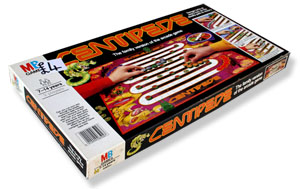
 Click on pictures to enlarge
Click on pictures to enlarge
|
In 1983, the world of board gaming was blessed by the release of Centipede.
Unlike Donkey Kong and Pac Man, the name 'Centipede' won't sound
familiar to anyone who didn't live in the 1980's and didn't spent their youth wasting
(some say) their pocket money in arcades. Centipede was an immensely popular
action game released by Atari in 1980. It takes place in a vast mushroom field
and the player controls a sort of humanoid-looking gun. The goal is to destroy an
ascending segmented centipede before it can reach the bottom of the screen.
This cardboard version uses slightly different rules - two players fight against each
other and they both have a gun and a centipede. You read this right, you have a centipede
 on your side in this version of the game. Each player starts from one side of the board
and must get his segmented centipede to the other player's base, a spin of the spinner decides
what action they should take next. Two kinds of mushrooms are scattered around the
playfield - the red ones are indestructible and can be used as shields, the yellow
ones are poisonous but can thankfully be blasted away. A Scorpion and Spider pawns,
controlled by the players, are also available and can either create or remove poison
mushrooms. The centipedes are nice pieces of engineering and each segment can be flipped
over if hit by a gun - and the same segments can later be revived by hitting the
opponent's centipede. This board game uses an elegant way to turn a shooter
into a 'two player' experience but ends up being a mixture of bland-but-workable
ideas.
on your side in this version of the game. Each player starts from one side of the board
and must get his segmented centipede to the other player's base, a spin of the spinner decides
what action they should take next. Two kinds of mushrooms are scattered around the
playfield - the red ones are indestructible and can be used as shields, the yellow
ones are poisonous but can thankfully be blasted away. A Scorpion and Spider pawns,
controlled by the players, are also available and can either create or remove poison
mushrooms. The centipedes are nice pieces of engineering and each segment can be flipped
over if hit by a gun - and the same segments can later be revived by hitting the
opponent's centipede. This board game uses an elegant way to turn a shooter
into a 'two player' experience but ends up being a mixture of bland-but-workable
ideas.


 Click on pictures to enlarge
Click on pictures to enlarge
|
The original Zaxxon game by Sega was a mini-revolution in itself.
Not many games, back in the 1980's, managed to amaze as much as the neat 3D isometric
graphics featured in Zaxxon. Milton Bradley tried, in a way, to infuse
the boardgame version with some of the elements that made Zaxxon such a hit.
Like with the original game, the goal is to shoot the super-computer-robot Zaxxon
and to destroy all the enemy targets. The game comes with many parts - four walls,
four gun turrets, four missile silos, eight fuel tanks, four fighter planes and one Zaxxon.
Each player controls two planes and must shoot one target (silo or turret) ,one fuel tank
in the outer section, one fuel tank in the inner section and finally blow Zaxxon to pieces
to succeed. However, the game is sort of designed for two players - only two planes are available
 and four players have to team up to play Zaxxon.
During each turn, players throw a die at the same time
and spin a colored spinner - the resulting color indicates if the player should move
his plane or send it back to the start, or attack Zaxxon. Then things become
even more complex, walls can only be crossed at the low middle section, some gun turret
and missile silos can't be destroyed, a radar barrier influences the outcome of the
battle and so on... without forgetting Zaxxon itself that needs to be moved by the
players following some tricky rules. So there you have it, Zaxxon is not a walk in the
park and I wonder how many kids just ended up throwing out the rules and playing their
own way with the awesome plastic fighters, black walls and that crazy Zaxxon robot.
and four players have to team up to play Zaxxon.
During each turn, players throw a die at the same time
and spin a colored spinner - the resulting color indicates if the player should move
his plane or send it back to the start, or attack Zaxxon. Then things become
even more complex, walls can only be crossed at the low middle section, some gun turret
and missile silos can't be destroyed, a radar barrier influences the outcome of the
battle and so on... without forgetting Zaxxon itself that needs to be moved by the
players following some tricky rules. So there you have it, Zaxxon is not a walk in the
park and I wonder how many kids just ended up throwing out the rules and playing their
own way with the awesome plastic fighters, black walls and that crazy Zaxxon robot.

Milton Bradley was an important key player in this market (and still is,
even if it is now one of Hasbro's brand). All of the above games were found
in the United Kingdom and were also available (and translated) in other parts of
Europe such as France, Germany and Italy. However, a lot more
games were released in the United States and Canada and these versions showed some
differences - like variances in the box art and some of the plastic parts. Obviously,
other companies tried to move into this market and games were also produced by
Parker Brothers, Entex, Ideal (and its Flip Arcade game series)
and others. Here are some examples of
licensed board games available in the United States, Canada and Europe:
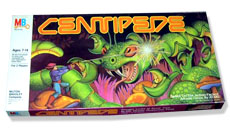 Centipede
Centipede
Milton Bradley / Atari
"Danger lurks at every turn
in the deadly mushroom field."
(US)
|
 Pac-Man
Pac-Man
Milton Bradley
"As much fun as the action packed
arcade game of the same name"
(US)
|
 Ms Pac-Man
Ms Pac-Man
Milton Bradley
"As much fun as the
action-packed arcade game."
(US)
|
 Defender
Defender
Milton Bradley
"Les envahisseurs étrangers"
(France)
|
 Donkey Kong
Donkey Kong
Milton Bradley
"Can you battle Donkey Kong
and save the fair maiden ?"
(US)
|
 Zaxxon
Zaxxon
Milton Bradley
"Based on the action-packed
arcade game by SEGA."
(US)
|
 Berzerk / Stern
Berzerk / Stern
Milton Bradley
"Can you survive the frenzied attack
of the robot army ?"
(US)
|
 Berzerk / Stern
Berzerk / Stern
Milton Bradley
"Can you survive the frenzied attack
of the robot army ?"
(UK)
|
 Frogger
Frogger
Milton Bradley
"One wrong leap will get you
squished and splattered."
(US)
|
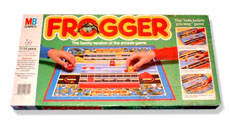 Frogger
Frogger
Milton Bradley
"The 'look before you leep' game."
(UK)
|
 Jungle Hunt
Jungle Hunt
Milton Bradley
"Can you dodge the mad monkey
and rescue the jungle girl?"
(US)
|
 Dragon's Lair
Dragon's Lair
Milton Bradley
"Can Dirk the daring
rescue princess Daghne ?"
(US)
|
|
|
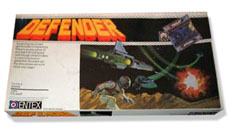 Defender
Defender
Entex
(US)
|
 Invader
Invader
Entex
(US)
|
 Turtles
Turtles
Entex
(US)
|
 Pitfall !
Pitfall !
Milton Bradley
"I'm Pitfall Harry
on an exciting treasure hunt !"
(US)
|
 The Legend Of Zelda
The Legend Of Zelda
Milton Bradley
"Conquer creepy creatures to control
the power of the Triforce !"
(US)
|
|
 Super Mario Bros
Super Mario Bros
Milton Bradley
"Defeat a world full of ferocious foes
and rescue the princess !"
(US)
|
 Super Mario Bros
Super Mario Bros
Waddingtons
(US)
|
 Sonic The Hedgehog
Sonic The Hedgehog
Milton Bradley
"Help your favorite rod runner
defeat the evil Dr.Robotnik !"
(US)
|
 Pole Position
Pole Position
Parker Brothers - Arcade Home Series
"The fast track auto-racing board game."
(US)
|
 Popeye
Popeye
Parker Brothers
"A board game based on
the exciting arcade game!"
(US)
|
 Q*Bert
Q*Bert
Parker Brothers
"A board game based on
the exciting arcade game!"
(US)
|
 Turbo
Turbo
Milton Bradley / Sega
"Based on the exciting
arcade game by SEGA"
(US)
|
 Turbo
Turbo
Milton Bradley / Sega
"You're in the driver's seat
for high-speed fun !"
(UK)
|
 Street Fighter II
Street Fighter II
Milton Bradley / Capcom
"Battle the world warriors in this
game of strength and courage !"
(US)
|
 Tetris
Tetris
Milton Bradley / Nintendo
"The relentless building
block game !"
(US)
|
 Tetris
Tetris
Tomy
"The ultimate test of advanced
territorial strategy for
all the family"
(UK)
|
 Tamagotchi
Tamagotchi
??
"An interactive game to play
with or without your
Tamagotchi toy."
(US)
|
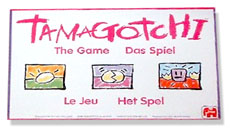 Tamagotchi
Tamagotchi
??
(Europe)
|
 Myst
Myst
University Games
"The puzzling new board
game adventure."
(US)
|
 DOOM (+ Expansion Set)
DOOM (+ Expansion Set)
Fantasy Flight Games / ID Software
"Lock Load Pray"
(US)
|
 Double Dragon
Double Dragon
Tiger
"Based on the action and strategy
of the smash hit video game."
(US)
|
 Tomb Raider - The Angel Of Darkness
Tomb Raider - The Angel Of Darkness
??
(US)
|
 Megaman NT Warrior
Megaman NT Warrior
Mattel / Capcom
(US)
|

What about Japan ? Mother country of most of the video game icons players
throughout the world cherish and respect. Was Japan also hit by the licensed
board game market ? The answer is 'Oh hell Yes' ! Most of the big names
including Nintendo, Namco, Capcom, Squaresoft/Epix
had their biggest franchises turned into board games - and, interestingly,
some game companies even published their own games ! People in the west see
video gaming as an evolution over board gaming, but in Japan, it looks like
the two genres actually merged - since the Famicom system, countless
digital board games flooded the Japanese video game market. This type of
game has yet to be seen in the west where it is still limited to digital
Checkers or Monopoly. Here is a non-exhaustive list of
licensed board games available in Japan :
 Senjyô No Ookami
Senjyô No Ookami
Bandai/Capcom
(Japan)
|
 Ganbare Goemon !
Ganbare Goemon !
Konami
(Japan)
|
 Dodge Ball Kunio Kun - Card game
Dodge Ball Kunio Kun - Card game
T.N.
(Japan)
|
 Dodge Ball Kunio Kun
Dodge Ball Kunio Kun
T.N./Technos Japan
(Japan)
|
 Alex Kidd Miracle World
Alex Kidd Miracle World
Sega Joy Board
(Japan)
|
 The Legend Of Kage
The Legend Of Kage
??
(Japan)
|
 Maraimera
Maraimera
(Ghost & Goblins)
Bandai/Capcom
(Japan)
|
 Donkey Kong Jr.
Donkey Kong Jr.
Nintendo/Takahashi
(Japan)
|
 Excite Bike
Excite Bike
Nintendo/Takahashi
(Japan)
|
 Super Mario Bros. 2
Super Mario Bros. 2
Bandai/Nintendo
(Japan)
|
 Super Mario Land
Super Mario Land
Bandai / Nintendo
(Japan)
|
 Super Mario Bros. DX
Super Mario Bros. DX
Bandai / Nintendo
(Japan)
|
 Lode Runner
Lode Runner
Broderbund/Tsukada Original
(Japan)
|
 Sky Destroyer
Sky Destroyer
Taito
(Japan)
|
|
 Genpei Tomaden
Genpei Tomaden
(Actual Famicom Game)
Namcot
(Japan)
|
 Mighty Bomb Jack
Mighty Bomb Jack
Bandai
(Japan)
|
 Crazy Climber
Crazy Climber
Tomy
(Japan)
|
 Gradius
Gradius
Bandai/Konami
(Japan)
|
 Valkyrie No Densetsu
Valkyrie No Densetsu
Namcot
(Japan)
|
 Super Xevious
Super Xevious
Namcot
(Japan)
|
 The Tower Of Druaga
The Tower Of Druaga
Namco
(Japan)
|
 Dragon Buster
Dragon Buster
Namcot
(Japan)
|
 Dragon Quest - Monster Scramble
Dragon Quest - Monster Scramble
Enix
(Japan)
|
 Momotarô Densetsu
Momotarô Densetsu
Takara/ Hudson Soft
(Japan)
|
 Dragon Quest I.II
Dragon Quest I.II
Enix
(Japan)
|
 Dragon Quest
Dragon Quest
Takara
(Japan)
|
 Dragon Quest - Alefgard
Dragon Quest - Alefgard
Enix
(Japan)
|
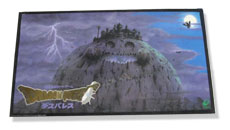 Dragon Quest - Death Palace
Dragon Quest - Death Palace
Enix
(Japan)
|
 Dragon Quest - Slime Race
Dragon Quest - Slime Race
Enix
(Japan)
|
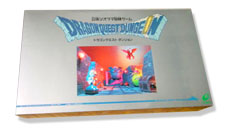 Dragon Quest Dungeon
Dragon Quest Dungeon
Enix
(Japan)
|
 Dragon Quest Dungeon II
Dragon Quest Dungeon II
Enix
(Japan)
|
 Dragon Quest Dungeon R
Dragon Quest Dungeon R
Square Enix
(Japan)
|
 F-Zero
F-Zero
Tomy/Nintendo
(Japan)
|
 Choh Makaimura
Choh Makaimura
(Super Ghouls 'n Ghosts)
??
(Japan)
|
 Donkey Kong Country
Donkey Kong Country
Takara/Nintendo
(Japan)
|
 Megaman Battlechip Tournament
Megaman Battlechip Tournament
Takara/Capcom
(Japan)
|
 Pocket Monsters
Pocket Monsters
Tomy/Nintendo
(Japan)
|
For the last twenty years, many players predicted that video games would wipe out the board
game industry. For that reason, we could see all the above licensed board games as an ironic
twist of fate. But no, video games didn't kill the board game market, on the contrary -
and we are grateful that the industry didn't rely on these licensed games to survive.
Like many licensed video games, they often suffer from weak content and rushed
production qualities. They often only exist for the sole reason of the characters pictured
on their front cover and have now become collector curiosities. Even today, the countless
licensed variations of timeless franchises such as Monopoly, Sorry or
Clue shows that board game companies have reached another extreme - they don't
even design a game around a license anymore, but simply transform an existing game to
endorse a license. Genius.
|
This is not directly related to this article but VGDen would like to give its condolences
to the family of Gary Gygax, co-creator of the role playing games Dungeons and Dragons,
who passed away on March 4, 2008 and whose work revolutionized both the board game and video game world.
|
Sources : Laurent Kermel's personal collection, various auction websites
Special Thanks : Carl Kaphan for spell checking the final article
All logos and trademarks
are © their respective owners.
This page content is
©2008 Video Game Den / Laurent KERMEL
|